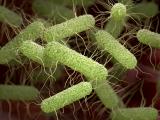Feb 22, 2007 (CIDRAP News) – A prolonged Salmonella outbreak linked to peanut butter has expanded to 329 cases in 41 states, an increase of 41 cases since the outbreak was announced on Feb 14, the US Centers for Disease Control and Prevention (CDC) said yesterday.
The Food and Drug Administration (FDA) has advised consumers not to eat any Peter Pan peanut butter produced since May 2006 or any Great Value brand peanut butter with a product code on the lid that begins with 2111. Both products are made at the same ConAgra plant in Sylvester, Ga., and epidemiologic studies have linked both with Salmonella enterica infections, according to the CDC and FDA.
S enterica typically causes fever and nonbloody diarrhea that resolves in a week. Of 249 patients for whom clinical information is available, 51 (21%) have been hospitalized in the outbreak, but no deaths have been reported. Illness onset dates, known for 224 patients, ranged from Aug. 1, 2006, to Feb. 2, 2007, according to the CDC. Sixty percent of the illnesses began after Dec 1.
Two closely related DNA fingerprints of S enterica serovar Tennessee have been associated with the outbreak, the CDC has said.
The current outbreak is the second known instance of Salmonella infections traced to peanut butter. In 1996, 15 people were sickened after eating peanut butter that was contaminated with S enterica serovar Mbandaka, according to a 1998 report published in the Australia and New Zealand Journal of Public Health. Investigators traced the contamination to roasted peanuts.
One earlier salmonellosis outbreak was linked to a snack that contained peanut butter. The outbreak, which involved more than 2,200 children in Israel, England, and Wales in 1994 and 1995, was traced to contamination of a peanut butter–coated snack popular with children in Israel.
In an investigation of peanut butter contamination, Sima Yaron, PhD, a senior lecturer at Technion-Israel Institute of Technology in Haifa, Israel, and her colleagues studied heat tolerance of three S enterica serovars. In the November 2006 issue of the Journal of Food Protection, they reported that the Salmonella strains could survive peanut butter pasteurization processes. They suggested that the pathogen may have increased heat resistance in foods that have low water and high lipid content, such as peanut butter and chocolate.
Yaron said that because Salmonella contamination is less common in peanut butter than in animal products, food companies and consumers don't approach peanut butter with the same level of caution. "However, the very low infection dose related to this product might cause extensive outbreaks in the few cases in which the peanuts are contaminated, as indeed happened this time or in many other countries in the past, including Israel," she told CIDRAP News in an e-mail message.
The findings about Salmonella's survivability in peanut butter have prompted recent interest from food companies, Yaron said. She added that her group is studying alternative pasteurization methods and the mechanisms Salmonella organisms use to survive in foods with low water and high lipid content.
See also:
Feb 21 CDC press release
http://www.cdc.gov/ncidod/dbmd/diseaseinfo/salmonellosis_2007/outbreak_notice.htm
CIDRAP overview of salmonellosis
http://www.cidrap.umn.edu/cidrap/content/fs/food-disease/causes/salmoview.html
Scheil W, Cameron S, Dalton C, et al. A South Australian Mdbandaka outbreak investigation using a database to select controls. Aust NZ J Public Health 1998 Aug;22(5):536-9
Shachar D, Yaron S. Heat tolerance of Salmonella enterica serovars agona, enteritidis, and typhimurimum in peanut butter. J Food Protec 2006 Nov;69(11):2687-91 [Abstract]

















